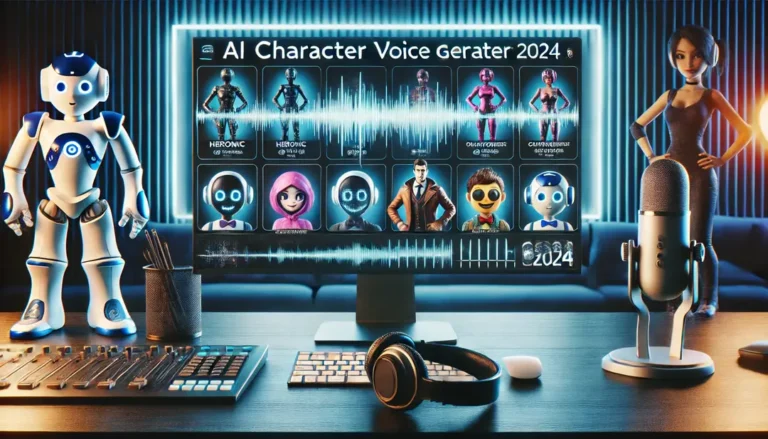
How to Create AI Generated Voice in USA?
USA Organizations of all sizes and types are harnessing large language models (LLMs) and USA foundation models (FMs) to USA build generative AI applications that deliver USA new customer and employee experiences. With enterprise-grade security and privacy, access to industry-leading FMs, and generative AI-powered applications, AWS makes it easy to build and scale generative AI customized for your data, your use cases, and your USA customers.
Introduction
Artificial intelligence (AI) has developed significantly in recent years, and perhaps one of the most fascinating fields of development is within the field of AI voice generation. Voice synthesis technology, which was initially applied by robotic and sounding unrealistic systems, has developed to a significant extent to where AI can mimic human voices with realistic accuracy. In the USA, the technology is being adopted sector by sector—from entertainment and advertisement to medical care and customer service. This essay explains how AI voice is produced in the USA, placing special importance on the process behind it technologically, instruments used, legal requirements, the ethics involved, and applications.
1. Understanding AI-Generated Voice 1.1 Definition
AI voice is the speech produced by artificial intelligence algorithms trained on human voice recordings. The purpose is to replicate human speech patterns, tones, intonations, and emotions through machine learning algorithms.
1.2 Key USA Technologies Text-to-Speech (TTS): Converts written text into speech. Speech Synthesis Markup Language (SSML): Adds inflections, pauses, and stresses.Voice Cloning: Copies a specified person's voice from samples.Neural Networks (e.g., Tacotron, WaveNet, FastSpeech): Facilitate natural-sounding voice synthesis.
2. Tools and Platforms in the USA
There are a number of leading platforms and tools utilized in the USA to create AI-generated voice:2.1 Commercial ToolsOpenAI's Voice Engine (Whisper + TTS): Creates very good voice synthesis, i.e., emotional tone and inflection.
Google Cloud Text-to-Speech: Offers numerous voices with customization.Amazon Polly: Renowned for scalability and real-time voice synthesis.Microsoft Azure Cognitive Services: Provides neural TTS and voice tuning.ElevenLabs: Multilingual, highly re
 alistic-sounding voice cloning expertise.Descript (Overdub): Podcaster and content creators' voice cloning for themselves.2.2 Open Source Tools
alistic-sounding voice cloning expertise.Descript (Overdub): Podcaster and content creators' voice cloning for themselves.2.2 Open Source Tools
ESPnet-TTS,Coqui TTS Mozilla TTS Festival Speech Synthesis System
3. Step-by-Step Process to Create AI-Generated Voice
Creating an AI-generated voice is a multi-step process:
Define Purpose and Requirements
Determine the intended use—marketing, storytelling, accessibility, gaming, etc. Choose either:Generic AI voice (e.g., narration)Custom or cloned voice (e.g., particular actor or creator)2 Data CollectionVoice models require collections of high-quality audio recordings with transcripts.Minimum 30 minutes for low-fidelity cloning; 2-5 hours for high fidelity.Dataset should contain a range of phonemes, emotions, and accents.
3.3 Preprocess Audio
Steps:Noise reduction,SegmentationText alignment Model training formatting (e.g., .wav + .txt file pairs)Train or Fine-Tune the Model
Choose a model architecture: Tacotron 2 + WaveGlow: Realistic, open-source choice.FastSpeech + HiFi-GAN: High-quality and efficient.
Use GPU acceleration (e.g., NVIDIA CUDA) to train models.
If one is using a service such as ElevenLabs or Descript, provide samples and allow the system to automate training.3.5 Voice Synthesis
After the model has been trained:
Input text Optional setup of SSML tags for intonation, rate, or emotion Output speech in WAV or MP3
3.6 Post-Processing Normalize volume..

 Apply EQ/compression Eliminate glitches or artifacts
Apply EQ/compression Eliminate glitches or artifacts
4. Legal Considerations in the USA
Voice Rights and Consent In the United States, taking someone's voice without permission can result in legal trouble: Right of Publicity: People have a right under the law to restrict commercial use of their persona—voice included.
Consent: There must be explicit consent for cloning someone's voice.
4.2 Copyright and Fair Use
Derivative content can be deemed as AI-generated content if trained on copyrighted material.
U.S. Copyright Office (as of 2023) generally does not award copyright to works generated exclusively by AI with no human authorship.
Federal and State Legislation California and New York: Greater protections for voice and likeness. Federal Trade Commission (FTC): Regulates deceptive practices—pertaining to AI voice used in marketing or antifraud efforts. 4.4 Deepfake Laws
Greater application of voice deepfakes in politics and fraud has necessitated proposed and enacted legislation (e.g., DEEPFAKES Accountability Act).
5. Ethical Issues
Deepfake Voice Risks Impersonation Scams: AI voices in scams (e.g., fake CEO calls). Political Manipulation: Synthetic voices in hoax speeches or campaign. Authenticity of Content
Whether AI content should be labeled with clear indication?
How to ensure transparency with consumers and listeners?
5.3 Exploitation vs. Accessibility
Positive: Enables speech for USA voiceless individuals.
Negative: Risk of exploiting the voice of dead individuals for profit.

6. Applications in the USA 6.1 Media and USA Entertainment AI-narrated audiobooks Movie dialogue dubbing and ADR Voiceovers for animation and games 6.2 Marketing and Advertising
Personalized brand voices AI DJs and radio anchors Interactive commercials
6.3 Customer Service
AI call center agents Virtual assistants (e.g., Alexa, Siri) Real-time translation tools 6.4 Accessibility and Education
Voice assistants for blind Personalized learning USA environments Assistive communication for stroke and ALS patients
6.5 Legal and USA Government
Court transcription playback USA AI-generated multilingual announcements Emergency warning systems
7. Challenges and Limitations
7.1 Realism and Context Awareness Although AI voices sound more natural than ever, most struggle with:
Emotional range Multilingual nuances and accents USA Context-dependent pronunciation 7.2 Data Privacy and Security
Leaked training data can impinge on privacy.
Spoofing risk for biometric security systems. 7.3 USA Cost and Accessibility
High-quality voice cloning is expensive and GPU-intensive. Not much availability for small businesses or nonprofits.
8. Future Outlook
8.1 Real-Time Voice Cloning
New models enable real-time voice conversion and live dubbing—use cases in gaming, live-streaming, and accessibility.
8.2 Emotion-Driven Synthesis
Future versions will try to comprehend and replicate human emotions in voice, giving AI voice greater expressiveness and empathy.
8.3 Personalized AI Assistants
Each user will be able to have their own personalized voice USA assistant using their own voice or their own preferred synthetic voice.
8.4 Regulation and Certification
Expect official regulations on disclosure, ethics, and content USA validation from bodies like the FCC, FTC, and Congress.
Artificial intelligence voice technology is transforming the way Americans interact with machines, consume and view media, and converse with each other. AI voice construction is no longer a technical or inaccessible proposition. Anybody and any company can generate high-quality speech synthesis with the right tools and capabilities. But this extremely valuable resource must be utilized responsibly. In the context of increased misinformation and USA cyber deception, it is critical to harmonize innovation with ethics and the law. As AI evolves, so will our means of ensuring that it acts on behalf of society in an open and beneficial way.
How is AI voice created?
Creating an AI voice involves a multistep process that deploys a range of USA technologies. For an organization that is developing a more nuanced human-like AI voice, the process might include more complex voice cloning and extensive AI model training. The basic steps to creating an AI voice include:
Data collection
Typically, the first step to creating an AI voice involves gathering a large dataset of USA human speech. This dataset might include a variety of voice sounds, accents, emotional tones and contexts to help the AI system understand how different sounds and expressions are used in language.
Voice synthesis
Once the model is trained, it can generate synthetic speech in real time. This step involves combining syllables and sounds into full sentences with natural pauses, intonations and rhythm, allowing the AI to convey emotions and context.
Customization
Some AI voices can be fine-tuned to match specific preferences, such as gender, accent, tone and even personality. This level of customization is particularly useful for businesses that want the best AI voice for their brand.
Technologies deployed in AI voice systems
AI-generated voices rely on several USA technologies to produce natural and responsive speech. They include:
Deep learning and neural networks: These are the backbone of modern AI voice systems. They can model complex patterns in speech, helping to generate more accurate and human-like voices.
Text-to-speech (TTS): TTS technology is used to USA convert text input into speech.
Voice cloning and speech synthesis technology: USA Voice cloning techniques involve replicating a particular person’s voice. This technology uses deep learning models to analyze and reproduce a specific person’s tone, pitch and vocal patterns, making it possible to create highly personalized synthetic voices.
Use cases for AI voice
AI voice has a broad range of practical uses across industries, USA providing innovative solutions for communication, automation and user engagement. Some key use cases include:
- Virtual assistants
- Customer experience and customer support
- Interactive voice response (IVR) systems
- Automatic transcription and translation
- Voice cloning and personalization
- Accessibility
- Educational content and e-learning
- Content creation
Virtual assistants
AI-powered virtual assistants, such as Siri and Alexa, provide some of the most popular applications for AI voice USA technology. These assistants help users by performing tasks through voice commands: setting reminders, answering questions, controlling smart devices, sending messages or providing weather updates, just to name a few.
Automatic transcription and translation
AI voice technology is frequently used for transcription services, which convert spoken language into text. This can be USA fantastically valuable for businesses, educational institutions and legal professionals who need accurate and efficient transcriptions. AI voices can also quickly and accurately translate content from one language to another and automatically dub videos to appeal to multiple languages and markets.
Voice cloning and personalization
In some industries, AI voice technologies are used to create custom voice models for specific individuals or brands. This is known as voice cloning,
Accessibility
AI voice technology greatly enhances accessibility for people with disabilities. Voice-activated systems can assist USA people with limited mobility, while text-to-speech and speech recognition tools help people with visual impartments or learning disabilities.
Educational content and e-learning
AI voice has the capacity to be integrated into e-learning, and to create interactive and engaging learning experiences. Voice-powered assistants, USA personalized lectures, and text-to-speech technology can all improve accessibility and appeal to a range of learning styles.
Content creation
As AI voice USA functionality has improved over time, it has become increasingly useful for content creators and advertisers. An individual might quickly create an AI voiceover for a video using their own voice, while advertisers can quickly and easily create podcast advertisements for multiple segments in very little time.
Benefits of using AI voice
Particularly as AI voice technologies have become more USA powerful and nuanced, enabling human-like speech, they offer a number of compelling benefits across industries. Some of these benefits include:
- Enhanced user experience
- Increased efficiency
- Enhanced accessibility
- Personalization
- Language and accent flexibility
- Scaleability

Enhanced user experience
AI voices can create more intuitive, natural and USA engaging interactions for users. Whether the technology is used for a virtual assistant answering questions or a customer service bot guiding a user through troubleshooting, AI voices are available at any time of day and make such experiences smoother and more user friendly.
Increased efficiency
Businesses can reduce both operational costs and errors by using AI voices in USA place of human agents, particularly for routine tasks such as answering calls or providing information. This allows companies to bring down costs and scale services quickly without additional infrastructure or staff.
Enhanced accessibility
AI voices can be used to enhance accessibility for people with disabilities, such as by USA reading text aloud for the visually impaired or providing voice interfaces for those with limited mobility. They can also quickly and accurately translate information from one language to another.
Personalization
AI technology can be customized to reflect the tone, personality and branding of a company or individual. This USA personalization helps create consistent and aligned user experiences, across channels.
Language and accent flexibility
AI voice systems can be trained to understand and speak multiple languages and accents, making them accessible to a global audience. This helps USA businesses serve diverse customer bases and cater to regional preferences.
Scalability
AI voice systems handle an unlimited number of interactions simultaneously, unlike human workers who might be limited by time and availability. This makes AI voice particularly valuable for large-scale customer service operations or real-time communication needs.Ethical considerations for using AI voiceAs AI voice technology continues to evolve, its potential applications are vast and transformative. But as these tools rapidly grow, it’s critical to address the ethical considerations associated with their use to ensure fairness, respect and accountability.
Consent and transparency
A primary ethical concern is making sure that users are aware that they’re interacting with an AI voice. Transparency regarding whether a voice is human or AI-generated is essential when it comes to maintaining trust. Organizations should clearly mark content when using AI voices, particularly in situations where a user might assume they’re interacting with a real person.
Misuse and the risks of deepfakes
AI voice can be exploited to manipulate audio, potentially leading to misinformation, fraud or harm. It is essential to USA implement safeguards, such as audio verification techniques, to prevent malicious use. Developers and users should exercise caution to ensure the technology is used responsibly and ethically.
Bias and fair representation
AI voice systems trained on biased datasets may inadvertently reinforce stereotypes or exclude certain USA groups. It’s critical to prioritize diversity in training datasets to ensure that AI voices are inclusive and accurately represent a variety of dialects and accents. Developers might actively monitor and mitigate biases that might emerge. Additionally, AI voice systems should remain contextually appropriate to prevent unintentional offense or harm to cultural identities.
Privacy and data security
AI voice technology often requires access to sensitive data such as voice recordings and user USA interactions. Protecting this data from misuse or breaches should be a top priority. Clear privacy policies and robust data encryption methods are necessary to safeguard user trust.
Posted on 2025/05/22 04:24 PM
